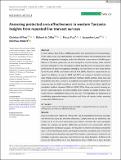| dc.description.abstract | In many parts of East Africa, wildlife populations have declined over the past decades. Given these trends, site-based studies are needed to assess how protected areas with differing management strategies enable the effective conservation of wildlife populations. In Tanzania, game reserves are managed for tourist hunting, while national parks are managed for non-consumptive wildlife-based tourism. To assess the relative performance of these management strategies, we here focus on two areas: Rukwa Game Reserve (RGR) and Katavi National Park (KNP). Based on systematically designed line distance surveys in 2004 and 2021, we compared densities and group sizes of large mammal populations (African elephant, giraffe, buffalo, zebra, topi, and hartebeest) over time. Contrary to published ecosystem-wide declines observed in numerous species which considered earlier baselines, we did not detect significant population declines between 2004 and 2021. While these new results showing apparent stable populations do not invalidate earlier studies on wildlife declines, they could indicate a stabilisation phase after declines. This highlights the importance of considering appropriate temporal baselines and historical contexts when assessing conservation effectiveness. | en_US |

